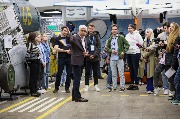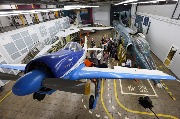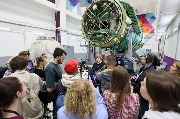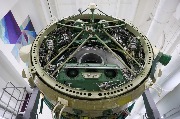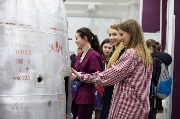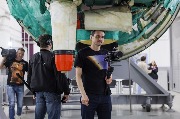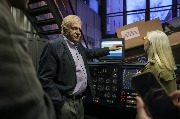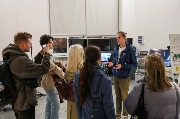MAI gave warm welcome to the participants of the first press tour of the "Science and Universities" national project
On April 6, the first press tour of the "Science and Universities" national project was carried out in Moscow and the Moscow Region. Moscow Aviation Institute and the Joint Institute for Nuclear Research showed modern developments, scientific laboratories, mega-science facilities and other objects of the popular science routes, created as part of the Popular Science Tourism initiative of the Decade of Science and Technology in Russia, announced by the Decree of the President of the Russian Federation.
The Popular Science Tourism initiative is aimed at increase of the availability of information about the achievements of Russian science. Unique popular science tours for schoolchildren, students and adult audiences are available in ten regions: Moscow, Moscow Region, Kaliningrad Region, Krasnodar Region, Amur Region, Irkutsk Region, Nizhny Novgorod Region, Novosibirsk Region, St. Petersburg and Kaluga Region. In 2023, the program will be expanded for 10 more regions. Currently, the program of the tour in the Tomsk Region is being formed.
“In order to achieve technological sovereignty, it is necessary to develop the research infrastructure and support scientific personnel systematically. In 2022, due to the national project "Science and Universities", more than 200 youth laboratories were created, the instrumentation base of 204 scientific organizations was updated, 9 more applications were selected, now 17 world-class campuses are participating in the program. Scientific and educational organizations that were included in the program of the first press tour along the popular science route also receive support from the “Science and Universities” national project and participate in the initiatives of the Decade of Science and Technology actively.” said Dmitry Chernyshenko, Deputy Prime Minister of Russia.
The first press tour in Moscow and the Moscow region took place at scientific facilities, research and educational centers that receive support under the "Science and Universities" national project. Guests visited Moscow Aviation Institute, which is part of the “Supersonic” world-class science center (WCRC), saw a mega-science facility – the NICA collider, which is being built on the basis of the Joint Institute for Nuclear Research in Dubna.
Journalists saw unique scientific facilities, many of which were previously unavailable to the audience. The original programs made it possible to feel like a full-fledged participant of the research process, look at science from an unexpected angle and plunge into the fascinating world of discoveries and future prospects.
“While compiling the program of the press tour, we paid special attention to the interactive part, so that anyone could “touch” science and make sure that this is an open and exciting area. For example, the participants of the press tour could try on the role of the operator of the NICA Collider, follow the complete chain of synthesis of new elements on the model of this collider, attend the launch of the Baikal Neutrino Telescope using VR glasses, visit a real orbital station and make a virtual flight while piloting an aircraft”, said Sofia Malyavina, General Director of ANO National Priorities.
At Moscow Aviation Institute, the press tour participants visited the Almaz orbital station, a full-sized space observation and research station. The station is designed for a crew of two to three people, the operating time in orbit is up to 410 days. Cosmonauts practice their actions on spacecraft of this type, simulating various stages of flight, as well as work in emergency situations. The orbital station is actively used in the educational process of future engineers.
The next platform was the educational laboratory of the department 101 "Design and certification of aviation equipment", where the participants of the event were able to examine samples of aviation equipment: Yak-40, MAI-890, Su-27, MiG-29, Yak-38, MiG-23, MI-24 and others.
It is worth mentioning that these locations are included in the Space Moscow tour as part of the popular science routes, which have already been successfully implemented at Moscow Aviation Institute since the beginning of this year. In total, two Decades of Science and Technology in Russia were developed with the participation of MAI within the framework of the Popular Science Tourism initiative. At the Avionics Center, created within the framework of the Priority 2030 program and implementing projects in advanced avionics equipment development, the guests saw a prototype stand for a human-machine interface for a supersonic commercial aircraft.
The final location of the press tour was the laboratory "Aerobatic stands and the "airplane-pilot" system", where the participants of the press tour were able to try themselves as pilots. On its basis research is carried out within the framework of the “Supersonic” world-class science center (WCRC).
Another unique object of the tour was the Joint Institute for Nuclear Research (JINR) in Dubna. JINR is the only international intergovernmental scientific organization in Russia, registered by the UN in 1957 and comprising 19 participating countries. The main areas of theoretical and experimental research are elementary particle physics, nuclear physics and condensed matter physics. The Institute is one of the leading organizations in the international scientific collaboration in the Baikal-GVD project - the creation of the Baikal Neutrino Telescope, it is here that the NICA mega-mining facility is being built. Over the past 10 years, 10 elements of the Periodic Table have been discovered at JINR, of which 115 (Moscovium, Mc), 105 (dubnium, Db), 118 (oganesson, Og) 114 (flerovium, Fl) are named after the Moscow region and the city of Dubna, Russian scientists Yury Oganesyan, currently working in JINR, and Georgy Flerov, one of the founders of the institute.
Detailed information about the main JINR studies and the history of the Institute's development was given at the Interactive Exhibition "JINR Basic Installations". The visitors of the excursion had the opportunity to see models of JINR's Dubna installations: a cyclotron, a collider with a particle detector, an IBR-2 pulse reactor and others. As well as the Baikal-GVD deep-sea neutrino telescope, located in the Irkutsk region.
Journalists were able to get into the JINR Laboratory of High Energy Physics and see a unique mega-science installation - the NICA accelerator complex. The NICA project is aimed at studying the critical states of nuclear matter under extreme conditions that arose after the Big Bang at the early stages of the evolution of the Universe. Such studies help to get better understanding of how our universe came about and how the world around us works. It is usually difficult to get to the NICA collider. First, the installation is located in a closed area. Second, NICA is actively preparing for launch and test sessions are regularly held at the complex, which last for 3-4 months. When the installation is turned on during the session, no one is allowed to be inside, even the scientists.
It was possible to try oneself as a scientist in the virtual laboratory of Dubna University, created with the assistance of JINR. The visitors took part in experiments in nuclear physics, and also saw real-time physical and chemical experiments. For example, via the experiments with liquid nitrogen, scientists have shown how materials change their properties at ultra-low temperatures.
During the press tour, speeches were delivered by Yury Oganesyan, Academician of the Russian Academy of Sciences, Scientific Director of the Flerov Nuclear Reactions Laboratory at JINR, Head of the Department of Nuclear Physics at Dubna University, Grigory Trubnikov, Doctor of Physical and Mathematical Sciences, Academician of the Russian Academy of Sciences, Director of the Joint Institute for Nuclear Research, Mikhail Pogosyan, Doctor of Technical Sciences, Academician of the Russian Academy of Sciences, Rector of Moscow Aviation Institute, and others.
